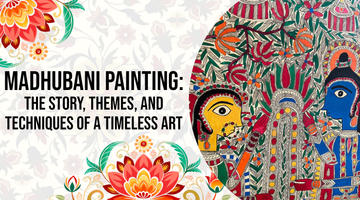India's rich artistic traditions and cultural legacy are seen in the unique and ageless art style of Madhubani painting, also known as Mithila art. This intricate and vibrant style of painting has captivated art lovers and collectors worldwide with its unique beauty and profound cultural significance.
Madhubani painting stands as a treasured Indian art form with a rich history and distinctive characteristics that make it truly special. In this blog, we will explore the story, themes, and techniques of Madhubani painting, delving into its origins, unique features, and modern practices.
We will cover the following main points: What is Madhubani painting? and the definition and origins of Madhubani art, its unique features, its cultural significance, common themes, materials and techniques used, modern practice and challenges, and ways to support and appreciate this traditional art form.What is Madhubani Art?
The Madhubani art, sometimes called Mithila art, comes from Bihar, India's Mithila area. Traditionally, women from the countryside have produced this art form, painting religious and social themes on the walls and floors of their homes with natural materials and paints. Over time, Madhubani art has evolved to be created on paper and canvas, making it accessible to a global audience.
The creative use of locally found materials is one of the distinctive characteristics of Madhubani painting. Artists use natural plant-based colors, cow dung for treating paper, and bamboo sticks as brushes. The intricate black outlines, created using bamboo sticks, add a distinct character to the paintings. These elements highlight the connection between the art form and nature, emphasizing sustainability and tradition.
Madhubani art holds immense cultural significance in Indian traditions. It is often used to mark auspicious occasions and festivals, depicting themes that resonate with the community's beliefs and values. The art form serves as a medium to pass down cultural narratives and folklore from one generation to another, preserving the region's rich heritage.
The Origins of Madhubani Art
The legend of King Janak of Mithila is often associated with the origins of Madhubani painting. It is thought that to remember his daughter Sita's marriage to Lord Rama, King Janak hired painters to produce paintings. This historical context adds a layer of mythological importance to the art form.
Traditionally, rice paste, natural dyes, and plant extracts were used to make Madhubani paintings on the walls and floors of mud homes. These paintings were not only decorative but also served as a means to express the artist's reverence for deities and nature.
From its humble beginnings on mud walls, Madhubani painting has evolved significantly. Today, artists create these paintings on paper, canvas, and fabric, using both traditional and modern techniques. The art form is now well-known throughout the world and is still evolving while keeping its historic qualities.
What is special about Madhubani painting
The Madhubani painting is unique for some reasons.
- Signature Style: The elaborate patterns, strong lines, and vivid colors of Madhubani paintings are well-known. Each piece of art is rich in significance because it frequently incorporates symbolic images, such as gods and goddesses, animals, and the natural world.
- Use of Natural Materials: Historically, Madhubani artists have worked with natural pigments and dyes derived from flowers, plants, and minerals. They also employ brushes made of fingers, twigs, and even matchsticks, which add a distinctive feel to the artwork.
- Cultural Significance: The Mithila region's rich cultural legacy is strongly ingrained in Madhubani art. It has been a vehicle for narrative and cultural expression for millennia, depicting social events, religious themes, and everyday life.
- Symmetry and Accuracy: Every piece in the paintings is carefully positioned, and they frequently exhibit amazing symmetry and accuracy. The Madhubani style is characterized by this degree of balance and intricacy.
- Female-Centric Tradition: Madhubani painting has historically been mostly done by women and has been inherited by them as a part of their cultural identity. It stands for the women's voices and inventiveness in the Mithila area.
- Diverse Themes: Modern Madhubani artists have broadened their subjects to encompass social and environmental issues, making the art form both ageless and relevant. Traditional themes typically center around mythology and religion.
-
International Recognition: The beauty and cultural richness of Madhubani painting have won it praise from all over the world. It remains an important element of India's artistic legacy and has been shown in galleries all around the world.
Also read:- Exploring the Diversity and Symbolism of Buddha Statues
Themes in Madhubani Painting
Themes of mythology and religion are common in Madhubani paintings. Gods like Saraswati, Laxmi, Ganesha, Shiva, and Radha and Krishna are among the often discussed topics. These paintings, which feature the divine in exquisite detail, frequently depict situations from Hindu epics and mythology.
Madhubani paintings also capture social scenes from rural Indian life. Artists depict daily activities, wedding ceremonies, harvests, and markets, reflecting the vibrancy and simplicity of rural life. These social themes provide an insight into the community's practices and traditions.
A recurrent theme in Madhubani's works is nature. Artists often portray elements such as the sun, moon, animals, sacred plants, and trees. These natural motifs symbolize the deep connection between humans and the environment, highlighting the importance of nature in their lives.
Materials and Techniques
Natural colors made from plants and other organic elements are used by Madhubani artists. For instance, blue is made using aparajita flowers, pink with bougainvillea, green with flat bean leaves, yellow with turmeric, and white with rice powder. These natural colors give the paintings a unique and earthy appeal.
The paper used for Madhubani painting is often treated with cow dung. This process not only makes the paper stronger but also creates a smooth painting surface. The process involves applying a thin layer of cow dung paste to the paper and allowing it to dry before starting the painting.
Bamboo sticks are used to create the intricate black outlines that are characteristic of Madhubani art. These outlines define the shapes and details of the painting, adding depth and precision to the artwork.
A Madhubani painting is made up of the following steps:
- Preparation of Materials: Gathering natural pigments, treating the paper with cow dung, and preparing bamboo sticks.
- Sketching the Outline: Using the bamboo stick to draw the intricate black outlines.
- Filling in Colors: Applying natural pigments to fill in the outlines, creating vibrant and detailed artwork.
- Final Touches: Adding finishing details and ensuring the painting is complete and polished.
Modern Practice and Challenges
Today, Madhubani artists continue to practice this traditional art form, adapting it to modern materials and techniques while preserving its essence. Many artists are now well-known across the globe, showing their work in galleries and shows all over the world.
Madhubani painting is popular, however it has a lot of problems. The commercialization of the art form has led to a decline in traditional techniques and materials. Also, it can be challenging for artists to find markets for their work that would support them, which makes it tough for them to make a living.
Initiatives from galleries, collectors, and organizations are among the efforts made to conserve and promote Madhubani art. These initiatives seek to assist artists, increase public knowledge of the art form, and guarantee its continued existence for upcoming generations.
How to Support and Appreciate Madhubani Art
Art collectors play a crucial role in preserving traditional art forms like Madhubani. By purchasing authentic paintings and supporting artists, collectors help sustain the art form and ensure its continued practice.
Laasya Art's Contribution to Promoting Madhubani Paintings
Laasya Art significantly promotes Madhubani paintings through various efforts:
- Showcasing Artists: Provides a platform for Madhubani artists to display their work globally.
- Online Presence: Offers a well-curated website for easy discovery and purchase of authentic paintings.
- Education and Awareness: Share informative content about the history, themes, and techniques of Madhubani art.
- Sustainable Practices: Supports traditional and sustainable creation methods.
- Collaborations and Exhibitions: Partners with galleries and cultural organizations to organize exhibitions.
- Artist Development: Artist development is the process of providing artists with tools and chances to grow both professionally and personally.
These initiatives help preserve and promote Madhubani paintings, ensuring their continued appreciation and survival.
Ways to Support
There are various methods by which you can assist Madhubani artists:
- Buy Authentic Paintings: Purchase original Madhubani paintings from reputable sources to support artists.
- Visit Galleries: Attend exhibitions and galleries showcasing Madhubani art to appreciate the work of talented artists.
- Raise Awareness: To help people understand the Madhubani painting's cultural value, tell your friends and family about it.
In this blog, we explored the painting entitled “What is Madhubani painting?” story, themes, and techniques of Madhubani painting. We discussed its definition and origins, unique features, cultural significance, common themes, materials and techniques used, modern practice and challenges, and ways to support this traditional art form.
Explore the timeless beauty of Madhubani paintings and support traditional Indian artists. Visit Saanskrityam Handicrafts to purchase authentic Madhubani art pieces today. improve your space with a piece of cultural heritage and make a meaningful impact by bringing home a Madhubani painting.
To keep the world diverse and varied, artistic preservation of cultural assets is crucial. We can make sure that Madhubani painting, an enduring art form, survives and inspires new generations by valuing and encouraging it.
FAQs:
1- What is the main theme of Madhubani painting?
The main themes of Madhubani painting include religious, social, and natural themes. Common subjects are mythological deities, rural life scenes, and natural elements like the sun, moon, animals, and plants.
2- What is Madhubani famous for?
Madhubani is famous for its intricate and vibrant paintings that use natural pigments and materials. It is also renowned for its cultural significance and traditional techniques.
3- Who invented Madhubani art?
The Mithila region of Bihar, India, is thought to be the birthplace of Madhubani art. The legend of King Janak commissioning artists to create paintings for his daughter Sita's wedding is often associated with its inception.
4- What is the famous of Madhubani paintings?
Madhubani paintings are famous for their unique style, intricate details, and use of natural colors. They are also known for their cultural and religious significance in Indian traditions.
5- How to identify Madhubani painting?
Madhubani paintings can be identified by their intricate black outlines, vibrant natural colors, and themes depicting mythological, social, and natural elements.
6- What are the five types of Madhubani painting?
Madhubani paintings come in five different varieties: Bharni, Kachni, Tantrik, Godna, and Kohbar. Every style has unique elements and methods of its own.






